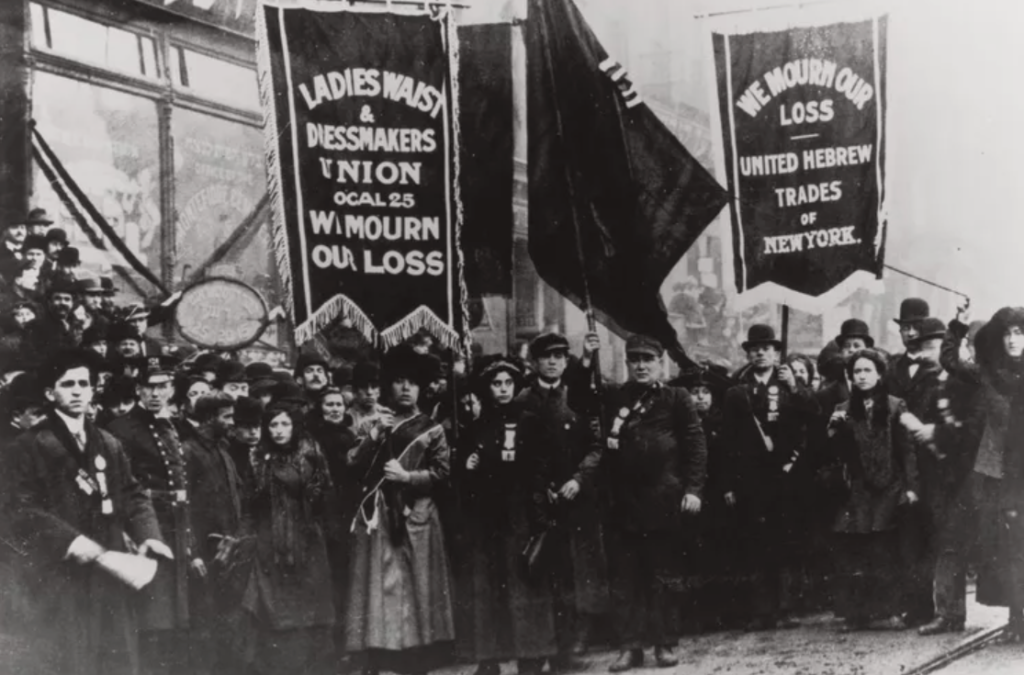Work Shouldn’t Result in a Death Sentence, but for too Many, it is

It took over a 110 years, but this week the Greenwich Village site of the Triangle Shirtwaist Factory Fire where 146 mostly young immigrant women garment workers lost their lives will be the scene of the dedication of a permanent memorial of the mass casualty event that inspired a national movement for workplace safety that still resonates today.
On March 25, 1911, the Triangle workers had to jump several stories to their deaths because the factory owners, who were staunchly anti-union, had locked the exits. The factory owners had resisted signing a union contract, unlike other garment factory owners who settled with the garment workers after their 1909 general strike when 20,000 garment workers, mostly women, took to the streets. They won a double digit pay raise and the recognition of their union.
The owners of the Triangle garment factory, Max Blanck and Isaac Harris—-also known as the “Shirtwaist Kings” —were acquitted of manslaughter. In the civil lawsuits that followed on behalf of the surviving families paid out roughly $75 per victim, several of whom were only 14 years old at the time of their death.
On Nov. 26, 1910, in Newark, just months before the Triangle tragedy, a High Street [now MLK Boulevard] garment factory fire killed 26 female garment workers. The blaze started after a container of gasoline spilled a floor below where the Wolf Muslin Undergarment Company was located.
“Most of the victims jumped to their deaths, some gruesomely impaled on a spike metal fence,” reported the New York Times in a detailed account of the original research done by the journalist Guy Sterling that confirmed the women who died ranged in age from 16 to 59.
In a moving YouTube interview from 2013, Sterling said the High Street blaze “historic significance had been lost in Newark. Sterling said that while the fire dominated local and even national media attention, the official Coroner’s Inquest found that “there was no culpability here, no one was to blame—that this particular incident was an accident and misadventure that’s the official reason given for the loss of these lives…No one was ever held to account.”
In recent years, there have been employers that have been held responsible for failing to comply with workplace safety protections.
Earlier this year, after an OSHA inspection of a Ho-Ho-Kus worksite found three employees on a roof 18 feet above ground without required fall protection, ALJ Home Improvement, a repeat offender, was fined close to $700,000.
“Since 2019, two employees of ALJ Home Improvement have suffered fatal falls and ALJ continues to callously ignore the law and blatantly jeopardize the safety of its workers,” said OSHA Area Director Lisa Levy in Hasbrouck Heights, New Jersey. “The company repeatedly refuses to comply with OSHA standards and make worker safety a priority, choosing instead to put profit over the lives of its employees. The reality is that a safe workplace is actually a more profitable workplace.”.
“Seven federal workplace safety inspections in the last four years that identified 33 violations, nine of them willful failures to provide required fall protection,” according to an OSHA press release. “And yet, the U.S. Department of Labor found ALJ Home Improvement Inc. of Nanuet, New York, again exposing its employees to potentially deadly harm in August 2022, just six months after an unprotected employee’s fatal fall.
Often, when someone gets killed on the job, their name doesn’t even make it into the news account. Take the reporting on an industrial accident this July at the United Premium Foods processing facility in Woodbridge where the victim was only identified “as a worker.”
And it’s not just the private sector that can run afoul of worker safety regulations. Consider that out of 93 OSHA fines levied so far in New Jersey so far this year, 18 were citations issued to several municipal DPWs, a sewer authority, a police department, a fire department, and a public library.
Work shouldn’t be a death sentence, yet a quarter of a century into the 21st century for thousands it is. And while it’s well documented that unionized workers enjoy better workplace safety protections, actual union density is hovering just above 10 percent, an all-time low, and well below the close to a third of American workers just after WWII.
In 2021, without really factoring in COVID, more than 5,000 workers died on the job. Another 120,000 workers died prematurely from a disease they had contracted as a consequence of their employment, according to the AFL-CIO’s 32nd annual report, Death on the Job: The Toll of Neglect.
The AFL-CIO’s annual 240-page research report is a national and state-by-state profile of worker safety and health data points from 2021 but has very limited COVID data because very little was collected by the agencies tracking workplace deaths.
The only government data on occupational COVID deaths was kept by the Centers for Medicare and Medicaid Services for nursing homes. Since June 2020, 3,009 nursing home workers have died from COVID with the country averaging 18 nursing home worker COVID deaths per week, according to the AFL-CIO research report.
“The true impact of COVID-19 infections due to workplace exposures is unknown,” the AFL-CIO asserted. “Limited data show that more than 1.5 million nursing home workers have been infected.”
Despite decades of progress in worker safety since the creation of the federal Occupational Safety and Health Administration in 1970, there’s troubling evidence of deadly backsliding particularly for the nation’s Black and Latino workers, according to a comprehensive analysis from the AFL-CIO, the nation’s largest labor federation.
In 2021, the fatality rate for Black workers spiked from 3.5 to 4.0 per 100,000 workers with more than 650 dying on the job, the most in nearly two decades,” according to the AFL-CIO’s annual report.
“Latino workers have the greatest risk of dying on the job, with a fatality rate at 4.5 per 100,000 workers that has grown by 13 percent over the past decade,” according to a press release that accompanied the report released to mark Worker Memorial Day on April 28. “There was also a slight uptick in deaths for Latino workers in 2021” with the overwhelming majority of the 1,130 who died being immigrants.








Governor Phil KNUCKLEHEAD Murphy ordered COVID-19 infected patients into highly susceptible assisted living, veterans and senior housing during the pandemic lockdowns. Over 7,000 compromised seniors and disabled died from COVID caused by this influx of the infected. Gov. Murphy is culpable and liable for the deaths of these over 7,000 people. The “buck stops with the Governor”. So, how come Murphy isn’t being charged, and tried for murder, or at the least, manslaughter??????
Based on NJ criminal penalties for manslaughter or murder, Murphy could face 70,000-280,000 years in prison. Why hasn’t he been brought to task on this??? Is it because he’s a Democrat-Socialist operative, that was part of the Obama Administration cabal (still running the Biden Administration)??? That would be discrimination against the rest of us who want to see justice done.